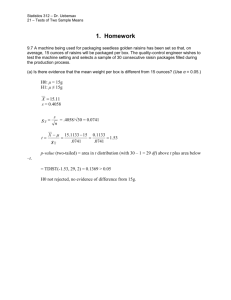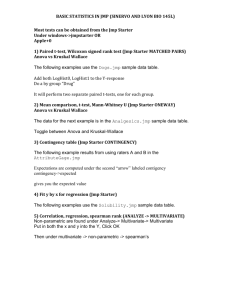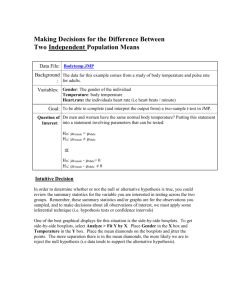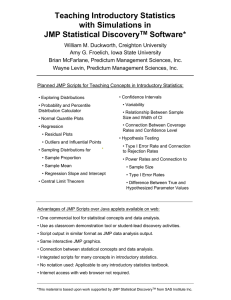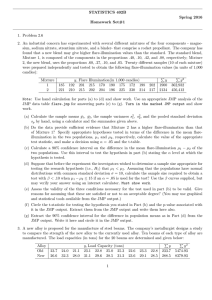Statistics 401D Spring 2016 Laboratory Assignment 5
advertisement
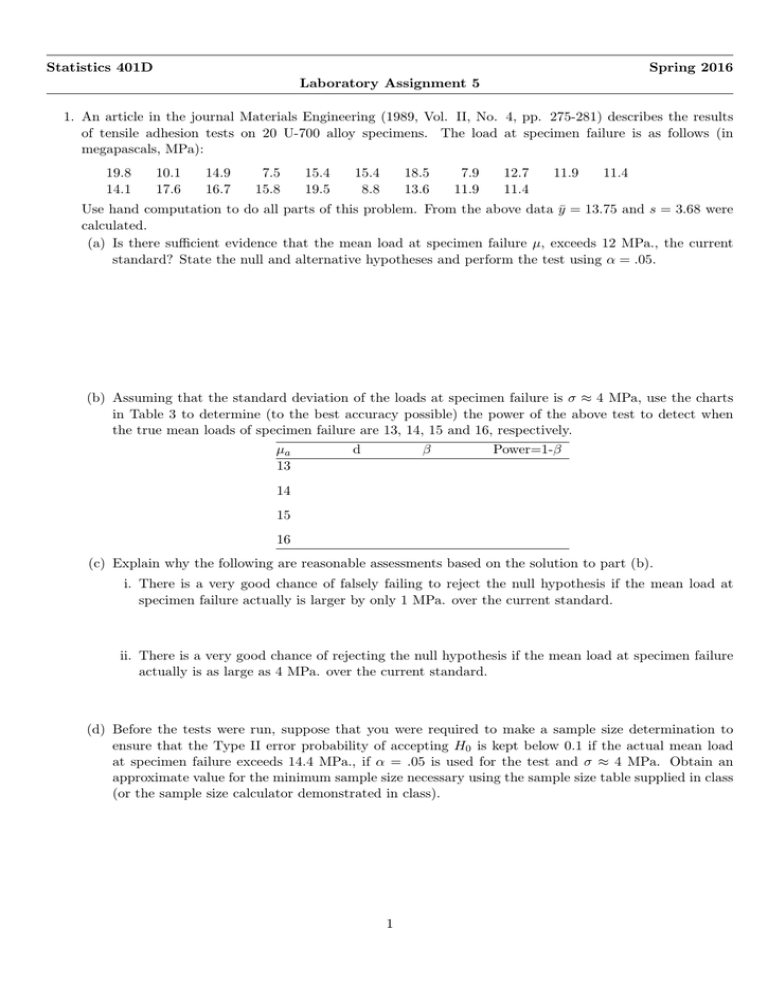
Statistics 401D Spring 2016 Laboratory Assignment 5 1. An article in the journal Materials Engineering (1989, Vol. II, No. 4, pp. 275-281) describes the results of tensile adhesion tests on 20 U-700 alloy specimens. The load at specimen failure is as follows (in megapascals, MPa): 19.8 14.1 10.1 17.6 14.9 16.7 7.5 15.8 15.4 19.5 15.4 8.8 18.5 13.6 7.9 11.9 12.7 11.4 11.9 11.4 Use hand computation to do all parts of this problem. From the above data ȳ = 13.75 and s = 3.68 were calculated. (a) Is there sufficient evidence that the mean load at specimen failure µ, exceeds 12 MPa., the current standard? State the null and alternative hypotheses and perform the test using α = .05. (b) Assuming that the standard deviation of the loads at specimen failure is σ ≈ 4 MPa, use the charts in Table 3 to determine (to the best accuracy possible) the power of the above test to detect when the true mean loads of specimen failure are 13, 14, 15 and 16, respectively. µa 13 d β Power=1-β 14 15 16 (c) Explain why the following are reasonable assessments based on the solution to part (b). i. There is a very good chance of falsely failing to reject the null hypothesis if the mean load at specimen failure actually is larger by only 1 MPa. over the current standard. ii. There is a very good chance of rejecting the null hypothesis if the mean load at specimen failure actually is as large as 4 MPa. over the current standard. (d) Before the tests were run, suppose that you were required to make a sample size determination to ensure that the Type II error probability of accepting H0 is kept below 0.1 if the actual mean load at specimen failure exceeds 14.4 MPa., if α = .05 is used for the test and σ ≈ 4 MPa. Obtain an approximate value for the minimum sample size necessary using the sample size table supplied in class (or the sample size calculator demonstrated in class). 1 2. An article in the Journal of the Environmental Engineering (“Distribution of Toxic Substances in Rivers,” 1982, Vol. 108, pp. 639-649) investigates the concentration of several hydrophobic organic substances in the Wolf River in Tennessee. Measurements on hexachlorobenzene (HCB) in nanograms (ng) per liter were taken downstream of an abandoned dump site. Data for 10 random locations at the surface and 10 different random locations at the bottom follow: P P 2 y y Depth y, Hexachlorobenzene (HCB), (ng/liter) Surface 3.74 4.61 4.00 4.67 4.87 5.12 4.52 5.29 5.74 5.48 48.04 234.3724 Bottom 5.44 6.88 5.37 5.44 5.03 6.48 4.89 5.85 6.85 7.16 59.39 358.9725 Note: Use hand calculation for parts (a) to (d) and show work. Use an appropriate JMP analysis of the data for answering parts (e) to (g). Turn in the marked JMP output and show work. (a) Calculate the sample means y¯1 , y¯2 , the sample variances s21 , s22 , and the pooled standard deviation sp by hand, using a calculator and the summaries given above. (b) Do the data provide sufficient evidence that the mean HCB concentration at the bottom is higher than at the surface? Specify appropriate hypotheses tested in terms of the difference in the mean HCB concentration in the two populations, µsurface and µbottom , respectively, calculate the value of the appropriate test statistic, and make a decision using α = .05, stating the rejection region clearly. (c) Calculate a 90% confidence interval on the difference in the mean HCB concentrations in the two populations µsurface − µbottom . Use this interval to test the hypothesis in part (b) stating the α level at which the hypothesis is tested. (d) Suppose that before the experiment the investigators wished to determine a sample size appropriate for testing the research hypothesis that µsurface < µbottom . Assuming that the populations have normal distributions with common standard deviation σ 2 = .5, calculate the sample size required to obtain a test for detecting a difference of 1.0 nanograms per liter with a power of at least .9 if an α = .05 is used for the test? Must show work. 2 (e) Assess the validity of the three conditions necessary for the test used in part (b) to be valid. Give reasons for assuming that these are satisfied or not to an acceptable degree? (You may use the graphics from the JMP outputs) (f) Circle the t-statistic for testing the hypothesis you stated in Part (b) and the p-value associated with it in the JMP output. Extract them from the JMP output and write them here also. (g) Extract the 90% confidence interval for the difference in population means as in Part (d) from the JMP output. Write it here and circle it in the JMP output. 3. In the development of coatings (such as for UV protection or anti-glare) for optical lenses, it is of interest to study the durability of the coating. One such durability test is an abrasion test, that simulates day-to-day usage of the lenses (such as cleaning by wiping with a Kleenex or a towel etc.). In this study two surface coatings A and B were compared by measuring the increase in haze after 200 cycles of abrasion. Fifteen lenses were coated with either A or B and tested in random order. Lower increase in haze is desired. Coating A B 8.52 10.73 9.21 8.00 y, Increase in Haze 10.45 10.23 8.75 9.32 9.75 8.71 10.45 11.38 9.65 9.10 11.42 n 7 8 P y 66.13 79.54 P 2 y 627.8173 801.9928 Note: Use hand calculation for parts (a) to (c) and show work. Use an appropriate JMP analysis of the data for answering parts (d),(e), and (f). Turn in the marked JMP output and show work. (a) Calculate the sample means ȳA and ȳB and sample variances s2A and s2B , respectively, of the two samples. Is there evidence to believe that the variances of increase in haze for the two populations of coated lenses are different? Explain. (b) Calculate, by hand, Welch’s two-sample t-statistic and perform a test of the hypothesis that there is a difference in the mean increase in haze between the two coatings. Use α = 0.05. State H0 and Ha in terms of appropriate population parameters you define and label clearly. Interpret your findings and show your work. (Continue on next page) 3 (c) Compute a 90% confidence interval for the difference in population means you defined in part (b) for the two populations assuming unequal population variances. (d) Report evidence you find from your JMP output (a) for supporting the normality assumption of the two samples, and (b) for supporting the conclusion that the population variances are not equal. (e) The t-statistic for testing the hypothesis you stated in Part (b) under the unequal variances assumption can be computed in JMP. Circle it in the JMP output and copy here the statistic and the p-value associated with it extracted from the JMP output. (f) Extract the 99% confidence interval for the difference in population means as in Part (c) computed under unequal variances assumption from the JMP output. Copy it here and circle it in the JMP output. Due Tuesday, March 8th, 2016 (turn-in during the first 15 min. of the lab) 4

